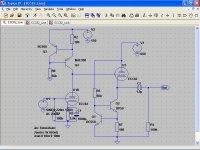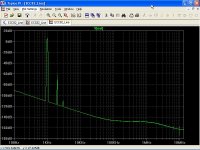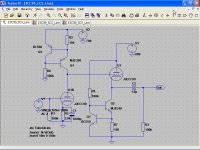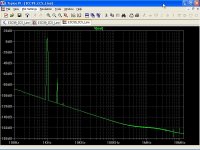Member
Joined 2009
Paid Member
Hi Bigun
Good to see you here, I'm still laughing, very good quote!
The paper that you told me I had read time ago, is very good, I didn't know it was Wavebourn.
I appreciate your response, these are the contributions that make me feel among friends.
Best regards
Johann
Hi, thanks !
Actually, I way complimenting Wavebourn by saying he could have written it, but actually he didn't, it was another person who's name is at the top of the web page I linked.
I have some Russian 6N23Pi tubes, they are very similar to ECC88. I'm thinking of making a simple common cathode pre-amp - like you are doing - it's fun to experiment ! But I have this little heater transformer good enough for one tube only so for stereo I can't use the SRPP approach you are investigating since I have only one triode per channel.
Hy Tonyjohann, just go out there and build yourself a triode preamp.....this is what you wanted to do, yes? there are lots of data in those databooks that you can use......
Thanks for your feedback, I have a lot of handbooks.
Forgive me for what was said in post # 14, it was not my intention, just now learning to use the Quote button, the comment was not for you.
It really helped me your link.
Best regards
Johann
Hi Bigun
Ah, now I understand.
They say good things about Russian valves.
Do not miss the opportunity of a SRPP only by a transformer.
Winding transformers is like fishing, or relaxes you or makes you crazy.
Why not a single transformer, custom made for a pre-amp, is not very expensive, and have fewer headaches with fields.
You can also take courage and winding yourself.
I'm finishing a PT for a pre-amp, two PT and two OPT for 25W monoblocks, thought that with Mom sewing machine would be easy, but don't, I had to do turn after turn, interleaved with epoxy and nomex, more than 80 total windings, I went crazy, but only one is easier.
Was mi first time, and now I'm "Hashimoto"
Ah, now I understand.
They say good things about Russian valves.
Do not miss the opportunity of a SRPP only by a transformer.
Winding transformers is like fishing, or relaxes you or makes you crazy.
Why not a single transformer, custom made for a pre-amp, is not very expensive, and have fewer headaches with fields.
You can also take courage and winding yourself.
I'm finishing a PT for a pre-amp, two PT and two OPT for 25W monoblocks, thought that with Mom sewing machine would be easy, but don't, I had to do turn after turn, interleaved with epoxy and nomex, more than 80 total windings, I went crazy, but only one is easier.
Was mi first time, and now I'm "Hashimoto"
Last edited:
As I said, even with such nice monitors I still hear sound of monitors amplified by amps. I don't hear sounds as if they are alive. That's the problem between your theoretical conclusions and my practical experience.
I listened to these frogs in my two systems (with different speakers). In both cases midrange frequencies are too emphasized to be natural. But it was much better, when I passed it through DTS Neo:6 in Cinema mode (in my Onkyo processor). So even simple simulated surround improved perception.
They say good things about Russian valves.
i have had very pleasant experience with the 6P3C, 6j9, 6H23, 6H1P's so far.....
i still have the 6H30, 6C33C tubes to try....
to me Russian tubes are good tubes....
even the Shuguang EL34 that i tried the other day are quite good, guess i am lucky so far....
Who can say that the ECC82/12AU7 is bad?
People who have actually measured them as opposed to simulation.
I've measured the linearity (or lack of same) on many 12AU7 examples, usually with circuits similar to the one you showed (the HV in that example is gratuitous). It is not a very linear tube. Your rather extreme earlier circuit may help, but as I mentioned before, you can achieve better linearity with other tubes and simpler circuits.
Even in simulation they're bad.People who have actually measured them as opposed to simulation.
Member
Joined 2009
Paid Member
I'm not very confident that the models used in simulations of tubes are very useful at the extremes of their operating range.
Why not build a *safe* high voltage supply with a regulator that allows you to vary the voltage over a wide range and listen to the circuit at different operating points. This will 'calibrate' the model results against real world results. If you find that you like the sound then you have something you can use. And learn from too.
Why not build a *safe* high voltage supply with a regulator that allows you to vary the voltage over a wide range and listen to the circuit at different operating points. This will 'calibrate' the model results against real world results. If you find that you like the sound then you have something you can use. And learn from too.
Hi Bigun
You mean something like this?
http://www.diyaudio.com/forums/tubes-valves/177063-my-first-power-supply.html
It remains a thought experiment.
BTW, what about this one?
Maybe you like it.
You mean something like this?
http://www.diyaudio.com/forums/tubes-valves/177063-my-first-power-supply.html
It remains a thought experiment.
BTW, what about this one?
Maybe you like it.
Attachments
Last edited:
I've measured the linearity (or lack of same) on many 12AU7 examples, usually with circuits similar to the one you showed (the HV in that example is gratuitous). It is not a very linear tube. Your rather extreme earlier circuit may help, but as I mentioned before, you can achieve better linearity with other tubes and simpler circuits.
Apparently you have not read what it says Wavebourn, in post # 53, # 71 and # 77, I respect a lot, their ideas may seem strange (not so much like mine), but I think he hit the spot.
He is also a gentleman, he don't scold me every time I say something.
Last edited:
Apparently you have not read what it says Wavebourn, in post # 53, # 71 and # 77, I respect a lot, their ideas may seem strange (not so much like mine), but I think he hit the spot.
He is also a gentleman, he don't scold me every time I say something.
I did not say that this tube on high voltages would amplify sound with minimal audible distortions. I said that linearization of ampliiers that contain inaudible distortions often lead to audible distortinos, that's it.
You've basically got half the B+ across each tube (equal cathode resistors), so you can easily pick off the operating point on the characteristic curves (325V Vak). It's safely in the conventional space-charge region, no need for fanciful explanations.
Thanks for your help, but do not help me so much.
Last edited:
Member
Joined 2009
Paid Member
Looks overly complicated to me. I was thinking of something simpler that you could get up and running more easily. But it must be safe from electrical shock hazard. Sorry I don't have a reference, but I'm confident folks on this forum could suggest an adjustable regulated HT supply design.
BTW, what about this one?
Maybe you like it.
It looks like common cathode amplifier followed by cathode follower buffer - and CCS load for each one. Worth a try I'd say. But I don't like that you think it's necessary to use two different B+ supplies - unnecessary extra work. I like your choice of ECC99, a tube with a very good reputation.
If you want to explore the sound of the high voltage / operation point question for the common cathode amp I'm not sure you want to add the complexity of making this a two stage design. I would suggest, if you will allow me to say, you will not gain much more from simulation but need to put some wires together on a bench. Feed the output through a 'clean' high input impedance solid state amp and some speakers. The listen. Try different operating points etc.
I don't know if you have seen this web site, it could take weeks to read it all, but it's a source of much information: Tube CAD Journal - read about the Aikido and about the Constant Current Draw Amplifier.
Last edited:
Hi Bigun
Thanks for your feedback.
I design an build audio equipment for my customers (not many), mine is DIY when I was 15 and sounds horrible.
I'm poor, and I can not finish my own.
The economy is not very good around here, I work a lot for little money and I have to settle for survival.
Oh, BTW, also I'm a TV repairman.
Thanks for your feedback.
I design an build audio equipment for my customers (not many), mine is DIY when I was 15 and sounds horrible.
I'm poor, and I can not finish my own.
The economy is not very good around here, I work a lot for little money and I have to settle for survival.
Oh, BTW, also I'm a TV repairman.
- Status
- This old topic is closed. If you want to reopen this topic, contact a moderator using the "Report Post" button.
- Home
- Member Areas
- The Lounge
- ECC82/12AU7 Line Preamp



